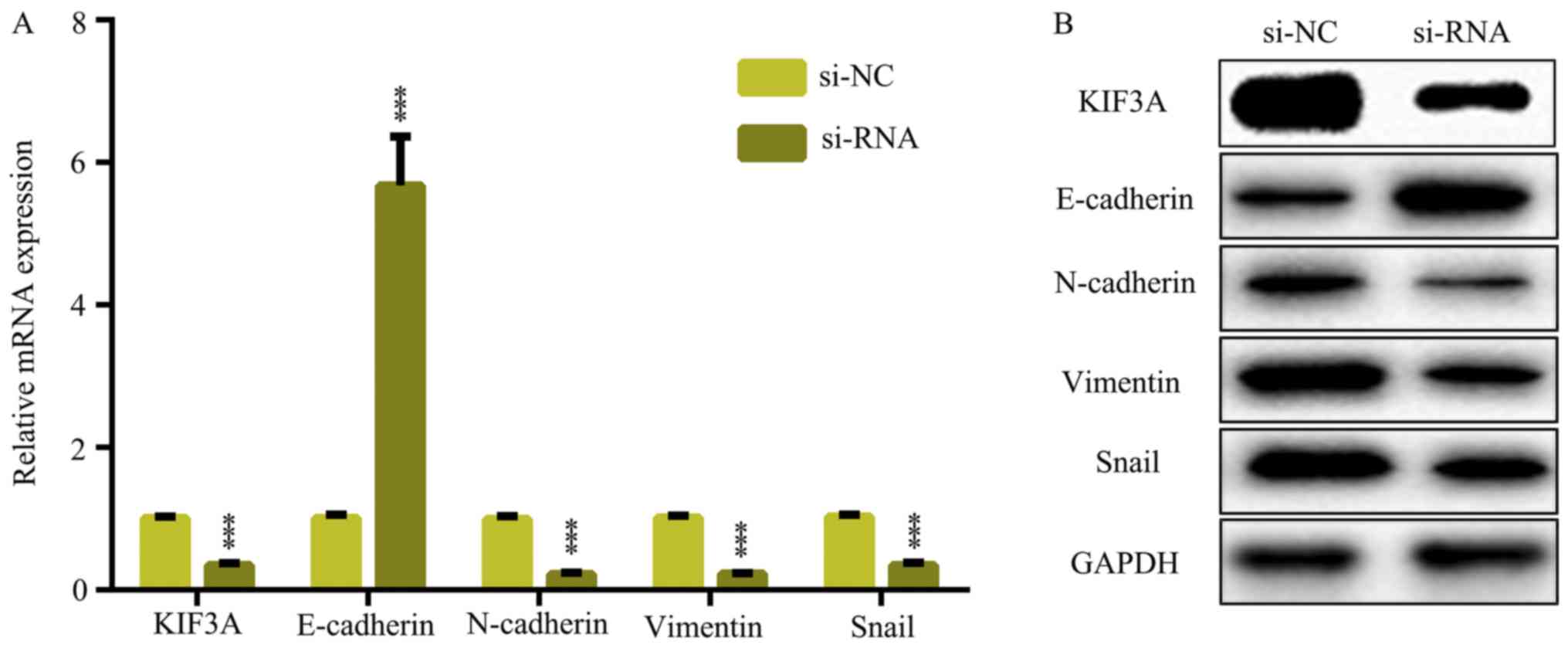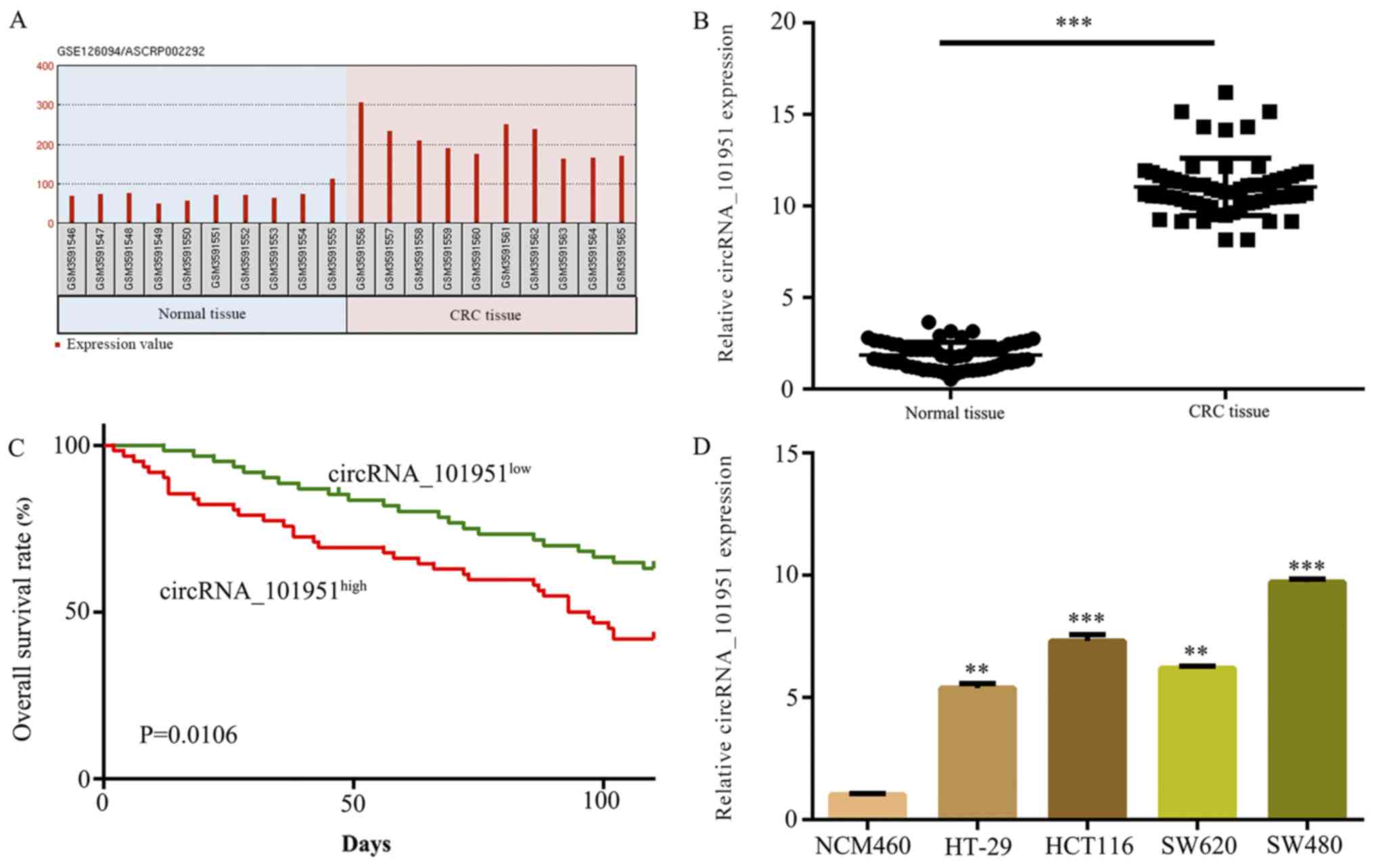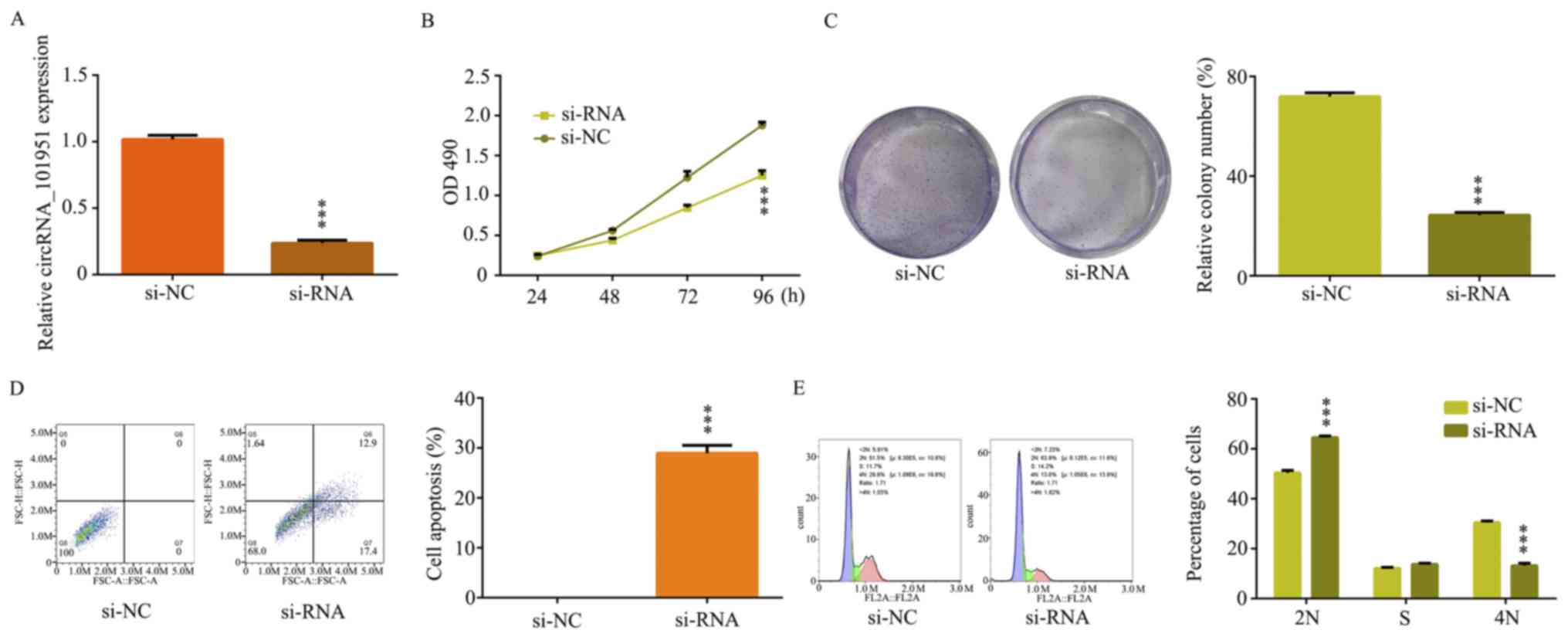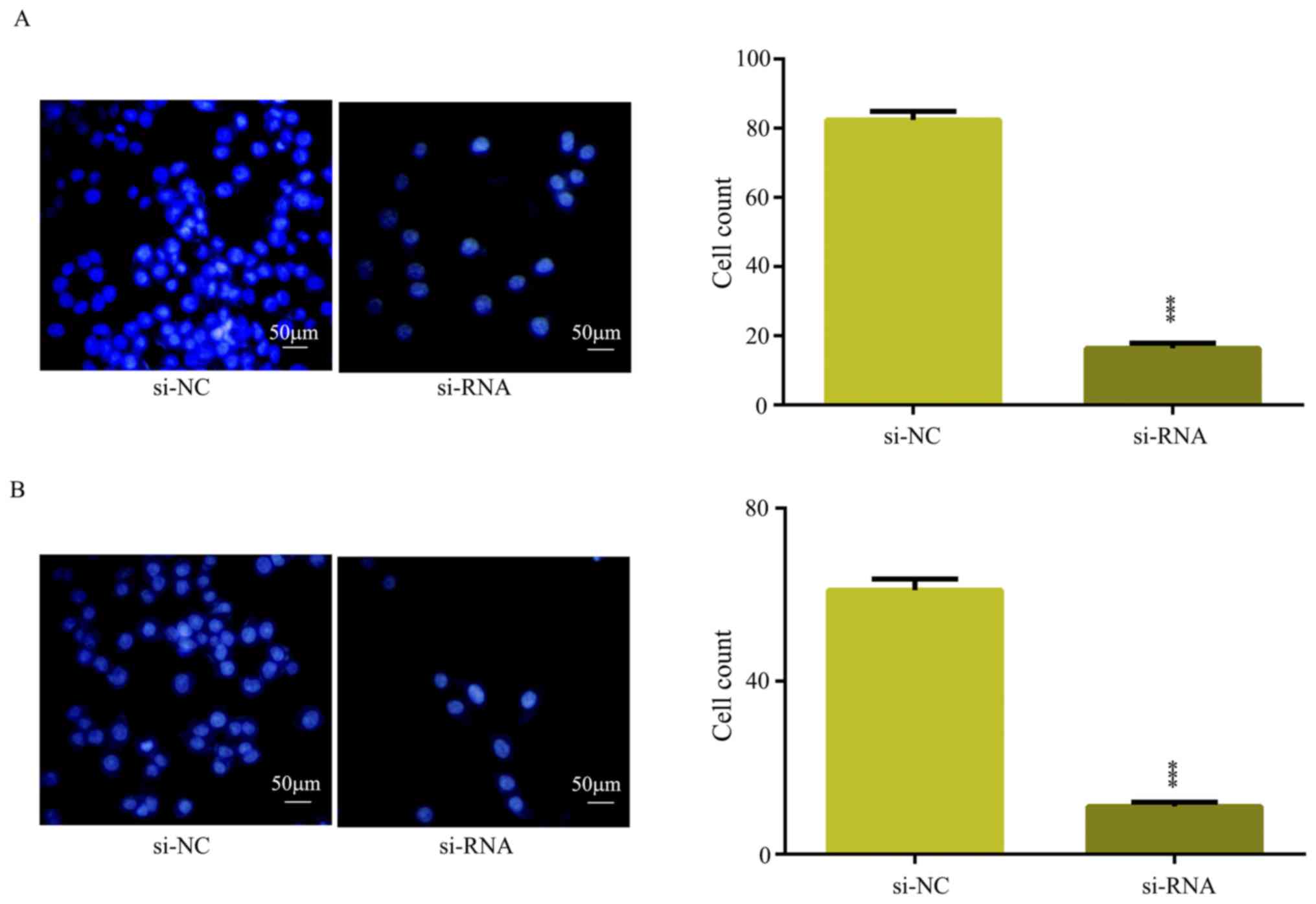Introduction
Currently, colorectal cancer (CRC) is one of the
most lethal tumor types worldwide (1). Although there is progress in the
clinical treatment of patients with CRC, the overall survival time
has not significantly improved in recent years (2). Migration, metastasis and invasion of
CRC cells are likely factors that lead to increased recurrence and
mortality in patients (3,4). Therefore, the identification of the
potential molecular mechanisms of action behind metastasis in CRC
is urgently required.
Circular RNAs (circRNAs), which are covalent closed
loops of RNA (5-7),
are reported to serve vital roles in the proliferation and
metastasis of tumors (8-12).
circRNAs have also been identified as potential biomarkers for the
early diagnosis of a variety of tumor types. For example, homo
sapien (hsa)_circ_0000520, which is a novel circRNA biomarker, is
involved in gastric carcinoma (13),
comprehensive circRNA profiling has also revealed that
hsa_circ_0005075 is involved in the development of hepatocellular
carcinoma (14). Additionally,
hsa_circ_0013958 has been identified as a circRNA and potential
novel biomarker for lung adenocarcinoma (15). In addition, circRNAs have been
demonstrated to promote the proliferation and metastasis of tumors
by sponging miRNA. For example, circRNA-zinc finger RNA binding
inhibited cell proliferation and promoted apoptosis in gastric
cancer by sponging miR-130a/miR-107 and modulating PTEN (16). CircRNA-proteasome 26S ATPase subunit
3 suppresses the proliferation and metastasis of gastric cancer by
acting as a competitive endogenous RNA through sponging miR-296-5p
(17). CircRNA-Filamin-binding LIM
protein 1 acts to promote hepatocellular cancer progression by
sponging miR-346(18). The
aforementioned studies revealed that circRNAs serve a major role in
the tumorigenesis of a variety of tumor types.
In the present study, the expression profile of
circRNAs in CRC tissues was examined by analyzing the microarray
data from the GEO dataset GSE126094. The results revealed that
circRNA_101951 was overexpressed in CRC tissues. circRNA_101951 is
a novel circRNA and the biological function and the mechanisms of
action of circRNA_101951 are currently undetermined. Therefore, the
present study demonstrated that circRNA_101951 promoted migration
and invasion of CRC cells by regulating the epithelial-mesenchymal
transition (EMT).
Materials and methods
Patients and specimens
The 62 pairs of CRC tissues and corresponding
adjacent normal tissues (obtained <3 cm from tumor tissue) were
collected from 62 patients (32 males and 30 females; age range,
26-88 years) who had undergone surgery in the Oncology Department
of Linyi Central Hospital (Linyi, China) between May 2015 to
December 2018. None of the patients received preoperative
radiotherapy or chemotherapy and all samples were collected
according to the guidelines of the Health Insurance Portability and
Accountability Act. Written informed consent was obtained from all
patients and the study was approved by the Board and Ethics
Committee of Linyi Central Hospital (approval no. 2018120102). To
explore the survival of 62 patients with CRC, patients were divided
into high and low circRNA_101951 expression groups according to the
median expression value (10.75). TNM was conducted as previously
described (19).
Cell culture
NCM460, a human colon mucosal epithelial cell line
(The Cell Bank of Type Culture Collection of the Chinese Academy of
Sciences) and four CRC cell lines (SW620, HCT116, SW480 and HT29)
were cultured in DMEM (Invitrogen; Thermo Fisher Scientific, Inc.)
supplemented with 10% FBS (Gibco; Thermo Fisher Scientific, Inc.)
at 37˚C with 5% CO2 atmosphere.
Bioinformatics analysis
The microarray data of the circRNA profiles in CRC
tissues and corresponding adjacent normal tissues were collected
from the NCBI GEO Datasets (https://www.ncbi.nlm.nih.gov/geo/query/acc.cgi?acc=GSE126094).
After applying a log2 transformation to the data, GEO2R (https://www.ncbi.nlm.nih.gov/geo/geo2r/)
was used to analyze the normalized microarray data (20).
Small interfering (si)RNA
transfections
The si-circRNA_101951 and si-negative control (NC)
were synthesized by Sangon Biotech Co., Ltd. The sequences of the
si-circRNA_101951 and si-NC were as follows:
5'-GUCUAGCUUAGAGUCUAU-3' and 5'-CAGAUUCGUUAGAGUCUAU-3',
respectively. Lipofectamine™ 2000 (Invitrogen; Thermo
Fisher Scientific, Inc.) were used in transient cell transfection.
siRNA (80 pmol) and Lipofectamine 2000 reagents (6 µl) were diluted
using 100 µl Opti-MEM medium (Invitrogen; Thermo Fisher Scientific,
Inc.) and incubated for 2 min at room temperature. Diluted RNA and
transfection reagents were subsequently mixed and incubated at room
temperature for 20 min. The mixture was then added to a 6-well
plate that was seeded with 2x105 cells. Further
experiments were performed 48 h after transfection.
MTT assay
The CRC cell proliferation was examined using MTT
assays (Sigma-Aldrich; Merck KGaA) following the manufacturer's
instructions. DMSO was used to dissolve the purple formazan and the
optical density value at 490 nm was measured on a microplate
reader.
Colony formation assay
Colony formation assays followed the standard
protocols as previously described (21). After 2 weeks of incubation at 37˚C
with 5% CO2, colonies were immobilized using 4%
paraformaldehyde (Sigma-Aldrich; Merck KGaA) at room temperature
for 10 min and stained with 2% crystal violet (Sigma-Aldrich; Merck
KGaA) at room temperature for 5 min. Colonies were subsequently
imaged with a camera (Nikon Corporation) and analyzed using IPP
Image-Pro Plus 6.0 software (Media Cybernetics, Inc.).
Cell cycle analysis
Cell cycle analysis was performed according to the
standard protocols of the CycleTEST™ PLUS DNA Reagent kit (cat. no.
340242, BD Biosciences) and analysis of the cell cycle were
determined using the PI reagent. Cells were counted using the BD
Accuri™ C6 flow cytometer (BD Biosciences) and analyzed using
FlowJo® 10.4.1 software.
Cell apoptosis assay
The cell apoptosis assay was performed according to
the standard protocols of the BD Pharmingen™ FITC Annexin V
Apoptosis Detection kit (cat. no. 556547, BD Biosciences). The
extent of cell apoptosis was then detected using FITC and PI
reagents. Cells were counted with BD Accuri™ C6 (BD Biosciences)
and analyzed using FlowJo® 10.4.1 software.
Cell migration
Cells were suspended in DMEM medium (Invitrogen;
Thermo Fisher Scientific, Inc.) without serum, and then
3x105 cells were seeded into the upper chamber of a
transwell insert (8.0 µm; BD Biosciences; 24 well-plate). DMEM
medium supplemented with 10% FBS was added to the lower chamber to
act as a chemoattractant. The cells were cultured for 8 h at 37˚C
with 5% CO2. Cotton swabs were used to remove the
non-invasive cells on the upper chambers. The migrated cells on the
lower membrane surface were fixed in 100% methanol at room
temperature for 15 min and washed in PBS three times. Then, the
migrated cells were stained using Hoechest 33342 at room
temperature for 30 min and imaged using a light microscope
(magnification, x100).
Cell invasion
Transwells (8.0 µm; BD Biosciences) were coated with
diluted Matrigel (BD Biosciences) in PBS and dried at room
temperature for 1 h. The remaining steps followed the
aforementioned protocol for the migration assays.
Reverse transcription-quantitative PCR
(RT-qPCR)
Total RNA was isolated from NCM460, SW620, HCT116,
SW480 and HT29, SW480 cell-si-NC and SW480 cell-si-circRNA_101951
cells using TRIzol® reagent (Invitrogen; Thermo Fisher
Scientific, Inc.) following the manufacturer's protocols. The mRNA
expression levels of kinesin II family member 3A (KIF3A),
E-cadherin, N-cadherin, vimentin and snail were examined using
RT-qPCR. cDNA was synthesized using the qPCR RT kit (Toyobo Life
Science) according to the manufacturers protocols. The temperature
protocol for reverse transcription was as follows: 37˚C for 15 min
and 98˚C for 5 min. The SYBR Green kit (Qiagen AB) was used for
quantitative PCR. GAPDH was used for the internal control. The ABI
Prism 7500 Sequence Detector (Applied Biosystems; Thermo Fisher
Scientific, Inc.) was used for the PCR reactions. The thermocycling
conditions were as follows: Denaturation at 95˚C for 30 sec;
followed by 40 cycles of annealing at 58˚C for 30 sec and extension
at 72˚C for 30 sec. The mRNA expression level was detected using
the relative quantitative gene expression method (22). The primer sequences used are listed
in Table I.
 | Table IPrimer sequences. |
Table I
Primer sequences.
| Names | Sequence |
|---|
| circRNA_101951 | F,
5'-TTAGTGACAAGGATCCAGGCGG-3' and R,
5'-TCCTCAGAAGCAGCCAGTACATCTC-3' |
| KIF3A | F,
5'-ACGCTGACGACATGGATAGAATCATG-3' and R,
5'-CAGTTTGGAGTTCCGATACGGCAC-3' |
| E-cadherin | F,
5'-CGAGAGCTACACGTTCACGG-3' and R, 5'-GGGTGTCGAGGGAAAAATAGG-3' |
| N-cadherin | F,
5'-AGCCAACCTTAACTGAGGAGT-3' and R, 5'-GGCAAGTTGATTGGAGGGATG-3' |
| Vimentin | F,
5'-TGGCACGTCTTGACCTTGAA-3' and R, 5'-GGTCATCGTGATGCTGAGAA-3' |
| Snail | F,
5'-CCTTCTCTAGGCCCTGGCT-3' and R, 5'-AGGTTGGAGCGGTCAGC-3' |
| GAPDH | F,
5'-GAAGGTGAAGGTCGGAGTC-3' and R, 5'-GAAGATGGTGATGGGATTTC-3' |
Western blot analysis
Total protein was extracted from treated cells using
IP lysis butter (cat. no. P0013J; Beyotime Institute of
Biotechnology). Subsequently, protein concentration was determined
by performing a bicinchoninic acid assay assay (cat. no. A53225;
Thermo Fisher Scientific, Inc.). Protein (25 µg) samples were
subjected to 8-12% SDS-PAGE and electro-transferred to PVDF
membranes. The membranes were then blocked with 5% skimmed milk at
room temperature for 2 h and incubated overnight at 4˚C with
primary antibodies against KIF3A (cat. no. sc-55598; 1:1,000),
E-cadherin (cat. no. sc-8426; 1:1,000), N-cadherin (cat. no
sc-8424; 1:1,000), vimentin (cat. no. sc-6260; 1:1,000), snail
(cat. no. sc-393172; 1:1,000) and GAPDH (cat. no. sc-47724;
1:1,000). All primary antibodies were purchased from Santa Cruz
Biotechnology, Inc. The membranes were subsequently incubated at
room temperature for 2 h with horseradish peroxidase-conjugated
anti-rabbit IgG secondary antibodies against anti-rabbit (cat. no.
7074; 1:2,000) and anti-mouse (cat. no. 7076; 1:2,000). All
secondary antibodies were purchased from Cell Signaling Technology,
Inc. Detection was performed using an ECL western blotting kit (GE
Healthcare) with the ChemicDoc XRS system (Bio-Rad Laboratories,
Inc.).
Statistical analysis
Statistical analysis was performed using SPSS
(version 15.0; SPSS, Inc.) and GraphPad Prism 6 (GraphPad Software,
Inc.). Student's t-test or one-way ANOVAs followed by a post-hoc
Tukey test was performed for calculation of statistical
differences. P<0.05 was considered to indicate a statistically
significant difference.
Results
CircRNA_101951 is upregulated in both
CRC clinical specimens and cell lines
circRNAs were initially evaluated in CRC by
retrieving the microarray data from the GEO dataset (GSE126094) and
normalized microarray data was analyzed using GEO2R after applying
a log2 transformation to the data. The microarray data demonstrated
that the expression levels of circRNA_101951 were increased in CRC
tissues compared with normal tissues (Fig. 1A). Furthermore, 62 pairs of CRC
tissues and normal tissues were collected to detect circRNA_101951
expression levels. The results revealed that circRNA_101951
expression levels were significantly upregulated in CRC tissues
compared with normal tissues (P<0.001; Fig. 1B). Kaplan-Meier survival analysis
indicated that higher expression levels of circRNA_101951 were
associated with a lower survival rate in patients with CRC
(Fig. 1C). The RT-qPCR assays
demonstrated that circRNA_101951 was significantly upregulated in
CRC cell lines compared with NCM460 cells (P<0.01 or P<0.001;
Fig. 1D). SW480 cells were selected
for further analysis as they exhibited the highest expression of
circRNA_101951.
CircRNA_101951 exerts a
tumor-promotive function in CRC
To assess the effect of circRNA_101951 on CRC cells,
SW480 cells were transfected with si-NC or si-circRNA_101951. The
RT-qPCR assays demonstrated that circRNA_101951 was significantly
decreased in SW480 cell-si-circRNA_101951 compared with SW480
cell-si-NC (P<0.001; Fig. 2A).
The MTT assays revealed that cell proliferation was significantly
inhibited in SW480 cell-si-circRNA_101951 compared with SW480
cell-si-NC (P<0.001; Fig. 2B).
Furthermore, the clone formation ability of the cells was
significantly reduced in SW480 cell-si-circRNA_101951 (P<0.001;
Fig. 2C). Subsequently, the flow
cytometry analysis was performed to further detect the effect of
circRNA_101951 on CRC cell apoptosis and the cell cycle
progression. The results indicated that the rate of apoptosis was
remarkably increased when SW480 cells were transfected with
si-circRNA_101951 (P<0.001; Fig.
2D). The proportion of G1 cells was markedly increased
following circ_101951 knockdown and the proportion of cells in the
G2 phase was markedly decreased after circ_101951 knockdown,
indicating G1 arrest (P<0.001; Fig.
2E). Therefore, circRNA_101951 may exert a tumor-promotive
function in CRC.
Downregulation of circRNA_101951
suppresses SW480 cell migration and invasion in vitro
In the present study, the overexpression of
circRNA_101951 was indicated to be associated with metastasis,
which suggested that circRNA may promote CRC migration and invasion
(Table II). To further verify
whether circRNA_101951 promoted CRC migration and invasion, cell
migration and invasion assays were performed to examine the
migration and invasion in CRC cells transfected with si-NC or
si-circRNA_101951. The results showed that downregulation of
circRNA_101951 significantly inhibited the migratory (P<0.001;
Fig. 3A) and invasive (P<0.001;
Fig. 3B) abilities of SW480.
Therefore, circRNA_101951 exerted a promotive function on the
migration and invasion of CRC cells.
 | Table IIRelationship between clinical features
and circRNA_101951 expression in patients with colorectal
cancer. |
Table II
Relationship between clinical features
and circRNA_101951 expression in patients with colorectal
cancer.
| | | circRNA_101951
expression | |
|---|
| Number of
variables | Cases | Low | High | P-value |
|---|
| Age (years) | | | | 0.349 |
|
<55 | 33 | 20 (9.94±1.56) | 13 (12.09±0.39) | |
|
≥55 | 29 | 11 (9.48±0.97) | 18 (12.26±0.61) | |
| Sex | | | | 1.739 |
|
Male | 32 | 17 (9.57±0.87) | 15 (12.11±0.55) | |
|
Female | 30 | 14 (9.33±1.12) | 16 (11.93±0.73) | |
| TNM stage | | | | <0.01 |
|
I-II | 25 | 23 (9.75±0.58) | 2 (10.79±0.83) | |
|
III-IV | 37 | 8 (10.23±0.75) | 29
(12.56±1.25) | |
| Tumor size | | | | <0.01 |
|
<5
cm | 24 | 20 (9.56±0.29) | 4 (10.56±0.57) | |
|
≥5 cm | 38 | 11 (9.27±1,12) | 27
(12.63±0.95) | |
| Metastasis | | | | <0.01 |
|
No | 30 | 24 (9.36±0.82) | 6 (10.25±0.81) | |
|
Yes | 32 | 7 (9.73±1.34) | 25 (13.051±28) | |
CircRNA_101951 modulates EMT of CRC
cells
The EMT is a critical cellular progress in tumor
migration and invasion. Therefore, to detect the effect of
circRNA_101951 suppression on EMT pathways, RT-qPCR and western
blot assays were performed. It was demonstrated that circRNA_101951
inhibitor decreased the mRNA and protein expression levels of KIF3A
as well as mesenchymal marker genes including N-cadherin, vimentin
and snail and increased the mRNA and protein expression levels of
the epithelial marker gene, E-cadherin (P<0.05; Fig. 4A and B). Thus, circRNA_101951 promoted the
migration and invasion of CRC by activating the KIF3A-mediated EMT
signaling pathway.
 | Figure 4circRNA_101951 modulates EMT of CRC
cells. (A) Reverse transcription-quantitative PCR was used to
examine the mRNA expression levels of KIF3A, E-cadherin, vimentin,
N-cadherin and snail in SW480 cells transfected with
si-circRNA_101951 or si-NC. (B) Western blotting was used to
examine the protein expression levels of KIF3A, E-cadherin,
vimentin, N-cadherin and snail in SW480 cells transfected with
si-circRNA_101951 or si-NC. The data shown represent the mean ±
standard deviation (n=3). ***P<0.001. circRNA,
circular RNA; KIF3a, kinesin II family member 3A; si-NC, negative
control small interfering RNA; si-RNA, small interfering RNA. |
Discussion
CRC development is a complex, dynamic and biological
process, and is associated with multiple genes. In addition, a
variety of circRNAs have been reported as either oncogenic or tumor
suppressive factors. For example, circRNA hsa_circ_000984 promotes
colon cancer growth and metastasis by sponging miR-106b (23). circRNA hsa_circ_0008039 promotes
breast cancer cell proliferation and migration by regulating the
miR-432-5p/E2F3 axis (24).
Hsa_circ_0079530 promotes cell proliferation and invasion in
non-small cell lung cancer (25).
Therefore, it is important to study the molecular mechanisms of
circRNAs in CRC.
Recently, it has been demonstrated that circRNAs are
useful as molecular biomarkers. For example, hsa_circ_0013958 is a
potential novel biomarker for lung adenocarcinoma (15), circPVT1 is a potential novel
biomarker in osteosarcoma (26) and
hsa_circ_0005986 acts as a novel biomarker for hepatocellular
carcinoma (27). In addition,
circRNAs also act as a sponge to inhibit the functions of miRNA.
For example, hsa_circ_000984 promotes colon cancer growth and
metastasis by sponging miR-106b (23). Increased circRNA hsa_circ_0012673
acts as a sponge of miR-22 to promote lung adenocarcinoma
proliferation (20).
Hsa_circRNA_0006528 acts as a competing endogenous RNA and promotes
human breast cancer progression by sponging miR-7-5p and activating
the MAPK/ERK signaling pathway (28). In the present study, a novel circRNA,
circRNA_101951, was identified and its function was examined. The
present study is, to the best of our knowledge, the first report
showing that circRNA_101951 promoted cell proliferation, migration
and invasion as well as inhibiting cell apoptosis in CRC. In
addition, RT-qPCR and western blot assays revealed that
circRNA_101951 promoted migration and invasion of CRC by activating
the KIF3A-mediated EMT signaling pathway. Therefore, circRNA_101951
exerts a tumor-promotive function and is a promising biomarker for
CRC.
In conclusion, circRNA_101951 is upregulated and
associated with the migration and invasion ability of CRC cells. In
addition, circRNA_101951 may promote CRC cell migration and
invasion by activating the KIF3A-mediated EMT signaling pathway.
Therefore, the present data revealed that circRNA_101951 may act as
a potential biomarker for patients with CRC and provide a novel
insight in to a potential therapeutic strategy for CRC.
Acknowledgements
Not applicable.
Funding
No funding received.
Availability of data and materials
The datasets used and/or analyzed in the current
study are available from the corresponding author on reasonable
request.
Authors' contributions
FLP conceived and designed the current study and
drafted the manuscript. YFL performed the experiments and analyzed
the data. MZC also performed the experiments. All authors read and
approved the final manuscript.
Ethics and approval and consent to
participate
Experiments involving patient tissues were approved
by The Ethics Committee of Linyi Central Hospital for Clinical
Ethical Review. Written consent was provided by all enrolled
patients.
Patient consent for publication
Not applicable.
Competing interests
The authors declare that they have no competing
interests.
References
|
1
|
Siegel RL, Miller KD and Jemal A: Cancer
statistics, 2018. CA Cancer J Clin. 68:7–30. 2018.PubMed/NCBI View Article : Google Scholar
|
|
2
|
Bopanna S, Ananthakrishnan AN, Kedia S,
Yajnik V and Ahuja V: Risk of colorectal cancer in Asian patients
with ulcerative colitis: A systematic review and meta-analysis.
Lancet Gastroenterol Hepatol. 2:269–276. 2017.PubMed/NCBI View Article : Google Scholar
|
|
3
|
Longo WE, Virgo KS, Johnson FE, Oprian CA,
Vernava AM, Wade TP, Phelan MA, Henderson WG, Daley J and Khuri SF:
Risk factors for morbidity and mortality after colectomy for colon
cancer. Dis Colon Rectum. 43:83–91. 2000.PubMed/NCBI View Article : Google Scholar
|
|
4
|
Kube R, Mroczkowski P, Granowski D,
Benedix F, Sahm M, Schmidt U, Gastinger I and Lippert H: Study
group Qualitätssicherung Kolon/Rektum-Karzinome (Primärtumor)
(Quality assurance in primary colorectal carcinoma): Anastomotic
leakage after colon cancer surgery: A predictor of significant
morbidity and hospital mortality, and diminished tumour-free
survival. Eur J Surg Oncol. 36:120–124. 2010.PubMed/NCBI View Article : Google Scholar
|
|
5
|
Qu S, Yang X, Li X, Wang J, Gao Y, Shang
R, Sun W, Dou K and Li H: Circular RNA: A new star of noncoding
RNAs. Cancer Lett. 365:141–148. 2015.PubMed/NCBI View Article : Google Scholar
|
|
6
|
Zhang HD, Jiang LH, Hou JC, Zhong SL, Zhou
SY, Zhu LP, Li J, Wang DD, Sun DW, Ji ZL and Tang JH: Circular RNA
hsa_circ_0052112 promotes cell migration and invasion by acting as
sponge for miR-125a-5p in breast cancer. Biomed Pharmacother.
107:1342–1353. 2018.PubMed/NCBI View Article : Google Scholar
|
|
7
|
Zhang M, Xia B, Xu Y, Zhang Y, Xu J and
Lou G: Circular RNA (hsa_circ_0051240) promotes cell proliferation,
migration and invasion in ovarian cancer through miR-637/KLK4 axis.
Artif Cells Nanomed Biotechnol. 47:1224–1233. 2019.PubMed/NCBI View Article : Google Scholar
|
|
8
|
Zhang XL, Xu LL and Wang F:
Hsa_circ_0020397 regulates colorectal cancer cell viability,
apoptosis and invasion by promoting the expression of the miR-138
targets TERT and PD-L1. Cell Biol Int. 41:1056–1064.
2017.PubMed/NCBI View Article : Google Scholar
|
|
9
|
Zhang Y, Liang W, Zhang P, Chen J, Qian H,
Zhang X and Xu W: Circular RNAs: Emerging cancer biomarkers and
targets. J Exp Clin Cancer Res. 36(152)2017.PubMed/NCBI View Article : Google Scholar
|
|
10
|
Zhang Z, Xie Q, He D, Ling Y, Li Y, Li J
and Zhang H: Circular RNA: New star, new hope in cancer. BMC
Cancer. 18(834)2018.PubMed/NCBI View Article : Google Scholar
|
|
11
|
Cortes-Lopez M and Miura P: Emerging
functions of circular RNAs. Yale J Biol Med. 89:527–537.
2016.PubMed/NCBI
|
|
12
|
Han YN, Xia SQ, Zhang YY, Zheng JH and Li
W: Circular RNAs: A novel type of biomarker and genetic tools in
cancer. Oncotarget. 8:64551–64563. 2017.PubMed/NCBI View Article : Google Scholar
|
|
13
|
Sun H, Tang W, Rong D, Jin H, Fu K, Zhang
W, Liu Z, Cao H and Cao X: Hsa_circ_0000520, a potential new
circular RNA biomarker, is involved in gastric carcinoma. Cancer
Biomark. 21:299–306. 2018.PubMed/NCBI View Article : Google Scholar
|
|
14
|
Shang X, Li G, Liu H, Li T, Liu J, Zhao Q
and Wang C: Comprehensive circular RNA profiling reveals that
hsa_circ_0005075, a new circular RNA biomarker, is involved in
hepatocellular crcinoma development. Medicine (Baltimore).
95(e3811)2016.PubMed/NCBI View Article : Google Scholar
|
|
15
|
Zhu X, Wang X, Wei S, Chen Y, Chen Y, Fan
X, Han S and Wu G: hsa_circ_0013958: A circular RNA and potential
novel biomarker for lung adenocarcinoma. FEBS J. 284:2170–2182.
2017.PubMed/NCBI View Article : Google Scholar
|
|
16
|
Liu T, Liu S, Xu Y, Shu R, Wang F, Chen C,
Zeng Y and Luo H: Circular RNA-ZFR inhibited cell proliferation and
promoted apoptosis in gastric cancer by sponging miR-130a/miR-107
and Modulating PTEN. Cancer Res Treat. 50:1396–417. 2018.PubMed/NCBI View Article : Google Scholar
|
|
17
|
Rong D, Lu C, Zhang B, Fu K, Zhao S, Tang
W and Cao H: CircPSMC3 suppresses the proliferation and metastasis
of gastric cancer by acting as a competitive endogenous RNA through
sponging miR-296-5p. Mol Cancer. 18(25)2019.PubMed/NCBI View Article : Google Scholar
|
|
18
|
Bai N, Peng E, Qiu X, Lyu N, Zhang Z, Tao
Y, Li X and Wang Z: circFBLIM1 act as a ceRNA to promote
hepatocellular cancer progression by sponging miR-346. J Exp Clin
Cancer Res. 37(172)2018.PubMed/NCBI View Article : Google Scholar
|
|
19
|
Greene FL, Stewart AK and Norton HJ: A new
TNM staging strategy for node-positive (stage III) colon cancer: An
analysis of 50,042 patients. Ann Surg. 236:416–421. 2002.PubMed/NCBI View Article : Google Scholar
|
|
20
|
Wang X, Zhu X, Zhang H, Wei S, Chen Y,
Chen Y, Wang F, Fan X, Han S and Wu G: Increased circular RNA
hsa_circ_0012673 acts as a sponge of miR-22 to promote lung
adenocarcinoma proliferation. Biochem Biophys Res Commun.
496:1069–1075. 2018.PubMed/NCBI View Article : Google Scholar
|
|
21
|
Zhou LH, Yang YC, Zhang RY, Wang P, Pang
MH and Liang LQ: CircRNA_0023642 promotes migration and invasion of
gastric cancer cells by regulating EMT. Eur Rev Med Pharmacol Sci.
22:2297–2303. 2018.PubMed/NCBI View Article : Google Scholar
|
|
22
|
Livak KJ and Schmittgen TD: Analysis of
relative gene expression data using real-time quantitative PCR and
the 2(-Delta Delta C(T)) method. Methods. 25:402–408.
2001.PubMed/NCBI View Article : Google Scholar
|
|
23
|
Xu XW, Zheng BA, Hu ZM, Qian ZY, Huang CJ,
Liu XQ and Wu WD: Circular RNA hsa_circ_000984 promotes colon
cancer growth and metastasis by sponging miR-106b. Oncotarget.
8:91674–91683. 2017.PubMed/NCBI View Article : Google Scholar
|
|
24
|
Liu Y, Lu C, Zhou Y, Zhang Z and Sun L:
Circular RNA hsa_circ_0008039 promotes breast cancer cell
proliferation and migration by regulating miR-432-5p/E2F3 axis.
Biochem Biophys Res Commun. 502:358–363. 2018.PubMed/NCBI View Article : Google Scholar
|
|
25
|
Li J, Wang J, Chen Z, Chen Y and Jin M:
Hsa_circ_0079530 promotes cell proliferation and invasion in
non-small cell lung cancer. Gene. 665:1–5. 2018.PubMed/NCBI View Article : Google Scholar
|
|
26
|
Kun-Peng Z, Xiao-Long M and Chun-Lin Z:
Overexpressed circPVT1, a potential new circular RNA biomarker,
contributes to doxorubicin and cisplatin resistance of osteosarcoma
cells by regulating ABCB1. Int J Biol Sci. 14:321–330.
2018.PubMed/NCBI View Article : Google Scholar
|
|
27
|
Fu L, Chen Q, Yao T, Li T, Ying S, Hu Y
and Guo J: Hsa_circ_0005986 inhibits carcinogenesis by acting as a
miR-129-5p sponge and is used as a novel biomarker for
hepatocellular carcinoma. Oncotarget. 8:43878–43888.
2017.PubMed/NCBI View Article : Google Scholar
|
|
28
|
Gao D, Qi X, Zhang X, Fang K, Guo Z and Li
L: hsa_circRNA_0006528 as a competing endogenous RNA promotes human
breast cancer progression by sponging miR-7-5p and activating the
MAPK/ERK signaling pathway. Mol Carcinog. 58:554–564.
2019.PubMed/NCBI View
Article : Google Scholar
|


















